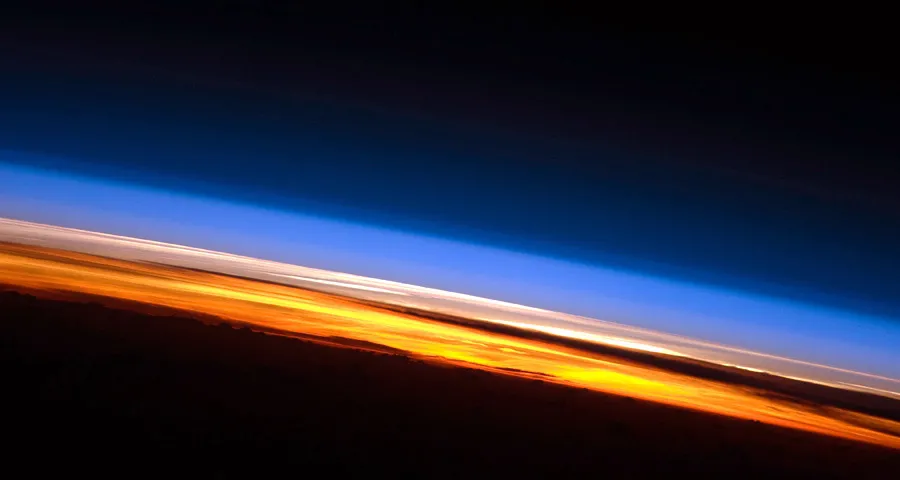What Is the Atmosphere?

The layered structure of Earth's atmosphere is visible in this sunset view from the International Space Station.
Image Science & Analysis Laboratory, NASA Johnson Space Center
The atmosphere is a mixture of gases that surrounds the Earth. It helps make life possible by providing us with air to breathe, shielding us from harmful ultraviolet (UV) radiation coming from the Sun, trapping heat to warm the planet, and preventing extreme temperature differences between day and night. Without the atmosphere, on average, temperatures would be well below freezing on Earth's surface. Instead, the heat absorbed and trapped by our atmosphere keeps our planet's average surface temperature at a balmy 15°C (59°F). Some of the atmosphere's gases, like carbon dioxide, are particularly good at absorbing and trapping radiation. Changes in the amounts of these gases directly affect our climate.
Gases in Earth's Atmosphere
Each of the planets in our solar system has an atmosphere, but none of them have the same ratio of gases or layered structure as Earth's atmosphere.
Nitrogen and oxygen are by far the most common gases in our atmosphere. Dry air is composed of about 78% nitrogen (N2) and about 21% oxygen (O2). The remaining less than 1% of the atmosphere is a mixture of gases, including argon (Ar) and carbon dioxide (CO2). The atmosphere also contains varying amounts of water vapor, on average about 1%. There are also many, tiny, solid or liquid particles, called aerosols, in the atmosphere. Aerosols can be made of dust, spores and pollen, salt from sea spray, volcanic ash, smoke, and pollutants introduced through human activity.
Earth's Atmosphere Has Layers
The atmosphere becomes thinner (less dense and lower in air pressure) the further it extends from the Earth's surface. It gradually gives way to the vacuum of space. There is no precise top of the atmosphere, but the area between 100-120 km (62-75 miles) above the Earth's surface is often considered the boundary between the atmosphere and space because the air is so thin here. However, there are measurable traces of atmospheric gases beyond this boundary, detectable for hundreds of kilometers/miles from Earth's surface.
There are several unique layers in Earth's atmosphere. Each has characteristic temperatures, pressures, and phenomena. We live in the troposphere, the layer closest to Earth's surface, where most clouds are found and almost all weather occurs. Some jet aircraft fly in the next layer, the stratosphere, which contains the jet streams and a region called the ozone layer. The next layer, the mesosphere, is the coldest because the there are almost no air molecules there to absorb heat energy. There are so few molecules for light to refract off of that the sky also changes from blue to black in this layer. And farthest from the surface we have the thermosphere, which absorbs much of the harmful radiation that reaches Earth from the Sun, causing this layer to reach extremely high temperatures. Beyond the thermosphere is the exosphere, which represents the transition from Earth's atmosphere to space.
Planetary Atmospheres
Earth is not the only world with an atmosphere. Each of the planets - and even a few moons - in our solar system have an atmosphere. Some planets have active atmospheres with clouds, wind, rain and powerful storms. Scientists use light spectroscopy to observe the atmospheres of planets and moons in other solar systems .
Each of the planets in our solar system has a uniquely structured atmosphere. The atmosphere of Mercury is extremely thin and is not very different from the vacuum of space. The gas giant planets in our solar system - Jupiter, Saturn, Uranus and Neptune - each have a thick, deep atmosphere. The smaller, rocky planets - Earth, Venus and Mars - each have thinner atmospheres, hovering above their solid surfaces. The moons in our solar system typically have thin atmospheres, with the exception of Saturn's moon, Titan. Air pressure at the surface of Titan is higher than on Earth! Of the five officially recognized dwarf planets, Pluto has a thin atmosphere that expands and collapses seasonally, and Ceres has an extremely thin and transient atmosphere made of water vapor.
But only Earth's atmosphere has the layered structure that traps enough of the Sun's energy for warmth while also blocking much of the harmful radiation from the Sun. This important balance is necessary to maintain life on Earth.
© 2021 UCAR